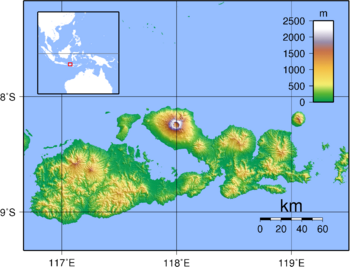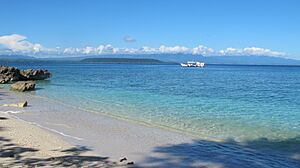Sumbawa facts for kids
 |
|
| Geography | |
|---|---|
| Location | Southeast Asia |
| Coordinates | 8°47′S 118°5′E / 8.783°S 118.083°E |
| Archipelago | Lesser Sunda Islands |
| Area | 15,323.77 km2 (5,916.54 sq mi) |
| Area rank | 57th |
| Highest elevation | 2,850 m (9,350 ft) |
| Highest point | Mount Tambora |
| Administration | |
|
Indonesia
|
|
| Province | West Nusa Tenggara |
| Demographics | |
| Demonym | Sumbawan |
| Population | 1,626,517 (mid 2022 estimate) |
| Pop. density | 106.14 /km2 (274.9 /sq mi) |
| Ethnic groups | Sumbawans, Bima people |

Sumbawa (Sumbawa: Semawa; Bima: Sombawa) is an Indonesian island, located in the middle of the Lesser Sunda Islands chain, with Lombok to the west, Flores to the east, and Sumba further to the southeast. Along with Lombok, it forms the province of West Nusa Tenggara, but there have been plans (currently held in abeyance) by the Indonesian government to split the island off into a separate province. Traditionally, the island is known as the source of sappanwood, as well as honey and sandalwood. Its savanna-like climate and vast grasslands are used to breed horses and cattle, as well as to hunt deer.
Sumbawa has an area (including minor offshore islands) of 15,323.77 square kilometres or 5,916.54 square miles (three times the size of Lombok) with a population (at the 2020 Census) of 1,561,461; the official estimate as at mid-2023 was 1,626,517. It marks the boundary between the islands to the west, which were influenced by religion and culture spreading from India, and the region to the east which was less influenced. In particular, this applies to both Hinduism and Islam. While the name "Sumbawa" is used by outsiders for the whole island, locally the term is only applied to the western half (Sumbawa and West Sumbawa Regencies), while the eastern half is referred to by inhabitants as "Bima" (meaning the city as well as Bima and Dompu Regencies), as the two parts of the island are divided by geography, culture and language.
Contents
Etymology
Sumbawa come from Portuguese Cumbava or Cimbava, assimilated from the locally used name Sambawa (still found as such in Makassarese, cf. also Semawa in the Sumbawa language). This name is probably derived from Sanskrit śāmbhawa (शम्भु), meaning 'related to Śambhu (= 'the Benevolent', a name for Shiva)'.
History
The 14th-century Nagarakretagama mentioned several principalities identified to be on Sumbawa; Dompu, Bima, Sape, and one on the Sang Hyang Api island just off the coast of northeast Sumbawa. Four principalities in western Sumbawa were dependencies of the Majapahit Empire of eastern Java. Because of Sumbawa's natural resources, it was regularly invaded by outside forces – from the Javanese, Balinese, and Makassar, to the Dutch and Japanese. The Dutch first arrived in 1605 but did not effectively rule Sumbawa until the early 20th century.
For a short period, the Balinese kingdom of Gelgel ruled a part of western Sumbawa. The eastern parts of the island were traditionally divided into four sultanates: Sumbawa, Sanggau, Dompo, and Bima, which had links to the Bugis and Makassar peoples of South Sulawesi.
Historical evidence indicates that people on Sumbawa island were known in the East Indies for their honey, horses, sappanwood, which is used to make red dye, and sandalwood, which is used for incense and medications. The area was thought to be highly productive agriculturally. In the 18th century, the Dutch introduced coffee plantations on the western slopes of Mount Tambora, a volcano on the north side of Sumbawa, thus creating the Tambora coffee variant.
Tambora's colossal eruption in 1815 was the most powerful in recorded history, ejecting 180 cubic kilometres (43 cu mi) of ash and debris into the atmosphere. The eruption killed up to 71,000 people and triggered a period of global cooling known as the "Year Without a Summer" in 1816. It also apparently destroyed a small culture of Papuan affinity, known to archaeologists as the "Tambora culture".
Administration
Sumbawa is administratively divided into four regencies (kabupaten) and one kota (city). The regencies and cities are listed below with their administrative capitals, their areas, and their populations at the 2010 census and the 2020 census, together with the official estimates as of mid-2023.
| Kode Wilayah |
Name of City or Regency |
Capital | Area in km2 |
Pop'n 2010 census |
Pop'n 2020 census |
Pop'n mid 2023 estimate |
HDI 2014 estimates |
|---|---|---|---|---|---|---|---|
| 52.04 | Sumbawa Regency | Sumbawa Besar | 6,643.99 | 415,789 | 509,753 | 529,487 | 0.628 (Medium) |
| 52.05 | Dompu Regency | Dompu | 2,324.55 | 218,973 | 236,665 | 247,188 | 0.635 (Medium) |
| 52.06 | Bima Regency | Woha | 4,389.40 | 439,228 | 514,105 | 535,530 | 0.626 (Medium) |
| 52.07 | West Sumbawa Regency (Sumbawa Barat) |
Taliwang | 1,743.58 | 114,951 | 145,798 | 152,950 | 0.671 (Medium) |
| 52.72 | Bima City | Bima | 222.25 | 142,579 | 155,140 | 161,362 | 0.722 (High) |
| Total Sumbawa | 15,323.77 | 1,331,520 | 1,561,461 | 1,626,517 |
Proposals have been under consideration since 2013 by the People's Representative Council (Dewan Perwakilan Rakyat or DPR) to create a separate Sumbawa Island province; there is no information as to whether the remaining part of the present province (i.e. the districts comprising Lombok Island) would then be renamed. However, since 2013 the Indonesian Government have maintained a moratorium on the intended creation of new provinces, regencies and cities.
Demographics
Islam, the dominant faith of the island, was introduced by the Makassarese of Sulawesi.
Sumbawa had, historically speaking, three major linguistic groups who spoke languages that were unintelligible to each other. The Sumbawa people centered on the western side of the island speak Basa Semawa (Indonesian: Bahasa Sumbawa) which is similar to the Sasak language from nearby Lombok; the Bima people in the east speak Nggahi Mbojo (Bahasa Bima), which is closer to the languages spoken on Flores and Sumba. They were once separated by the Tambora culture, which spoke a language related to neither. After the demise of Tambora due to the 1815 eruption, local kingdoms based in Sumbawa Besar and Bima became the two focal points of Sumbawa. This division of the island into two parts remains today; Sumbawa Besar and Bima are the two largest towns on the island (although the town of Dompu to the west of Bima has a greater urban area population than Sumbawa Besar), and are the centers of distinct cultural groups that share the island. The Don Donggo or "Mountain People" are a small minority ethnic group who occupy the cloudy highlands west of Bima Bay.
The population of the island (including minor outlying islands) was 1.56 million at the latest decennial census in 2020, comprising 29.46% of the population of the entire Province of West Nusa Tenggara's 5.32 million people; the official estimate as at mid-2023 was 1,626,517 - of whom 682,437 inhabit the western half and 944,080 the eastern half of the island.
Due to the lack of work opportunities on the island and its frequent droughts, many people on the island seek work in the Middle East as laborers or domestic servants; some 500,000 workers, or over 10% of the population of West Nusa Tenggara, have left the country to work overseas.
Geography
The island is bounded by bodies of water; to the west is Alas Strait, south is the Indian Ocean, Saleh Bay creates a major north-central indentation in the island, and the Flores Sea runs the length of the northern coastline. The Sape Strait lies to the east of the island and separates Sumbawa from Flores and the Komodo Islands, there are several bays and gulfs, most notably Bima Bay, Cempi Bay, and Waworada Bay.
Sumbawa's most distinguishing features are Saleh Bay and the Sanggar Peninsula. On the latter stands Mount Tambora (8°14’41” S, 117°59’35” E), a large stratovolcano famous for its VEI 7 eruption in 1815, one of only a few eruptions of such magnitude in the last 2,000 years. The eruption obliterated most of Tambora's summit, reducing its height by about a third and leaving a six-kilometer-wide caldera. Regardless, Tambora remains the highest point on the island. Highlands rise in four spots on the island, as well as on Sangeang Island. The large western lobe of Sumbawa is dominated by a large central highland, and Tambora, Dompu, and Bima each have more minor highlands.
There are several large surrounding islands, most notably Moyo Island, volcanically active Sangeang Island, and the tourist Komodo Islands (administered under Flores) to the east.
Sumbawa is part of the Lesser Sunda deciduous forests ecoregion.
List of offshore islands
There are several smaller offshore islands which fall within the regencies based on Sumbawa Island:
|
|
|
|
Economy
Many of the island residents are at risk of starvation when crops fail due to lack of rainfall. The majority of the population works in agriculture. Tourism is just beginning, with a few surf spots renowned for being world-class, Jelenga and Supersuck Beaches near the mine, as well as Hu'u and Lakey Beach in the Gulf of Cempi.
Newmont Mine
A large gold and copper mine, Newmont Mining Corporation's Batu Hijau mine began commercial operations in 2000, a decade after the copper and gold were discovered. Newmont holds a 45% stake in the operation through its shareholding in PT Newmont Nusa Tenggara. A local unit of Japan's Sumitomo Corporation has a 35% share. The mine is located in southwest Sumbawa.
Due to the mine, Sumbawa Barat Regency along with other remote mining towns, and Jakarta, has the highest GDP per capita rates in Indonesia, Sumbawa Barat's is 156.25 million rupiah (US$17,170) as of 2010[update], Newmont and its partners have invested about $1.9 billion in the mine. The reserves are expected to last until 2034, making Batu Hijau one of the largest copper mines in the world.
It is also one of the worst water-polluting mines, notably with at least three pipe breaks since its opening in 1999.
Another important deposit of gold and copper has been discovered in 2020 near Onto. PT Sumbawa Timur Mining (STM) hopes to start exploitation in 2030.
Transport
There is a road network in Sumbawa, but it is poorly maintained and has long portions of rough gravel. Frequent ferry service to Sumbawa (Poto Tano) from Lombok (Labuhan Lombok) exists; however, the ferry service to Flores from Sape is infrequent. Bima is the largest city on Sumbawa and has ferry and bus services directly to Java and Bali, though service breakdowns are common.
The most convenient way to reach Sumbawa is via air. Commercial flights connect the island's main airport, the Bima airport, to Denpasar and Makassar.
See also
 In Spanish: Sumbawa para niños
In Spanish: Sumbawa para niños





